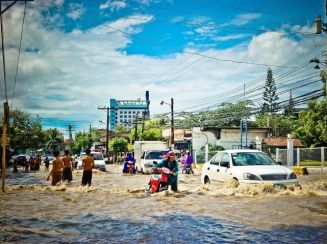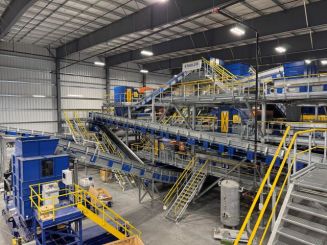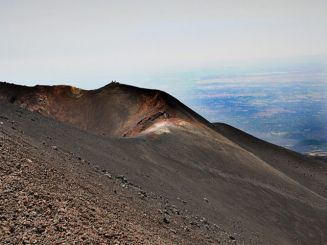Climate change and water: warmer oceans, flooding and droughts
Climate change is increasing the pressure on water bodies. From floods and droughts to ocean acidification and rising sea levels, the impacts of climate change on water are expected to intensify in the years ahead. These changes are prompting action across Europe.

Europe is affected by climate change and the impacts are not only felt on land. Europe’s water bodies — lakes, rivers and the oceans and seas around the continent — are also affected. As there is more water than land covering the Earth’s surface, it is no surprise that the warming of the oceans has accounted for around 93 % of the warming of the planet since the 1950s. This warming is happening as a result of increasing emissions of greenhouse gases, most importantly carbon dioxide, which in turn has increasingly trapped more solar energy within the atmosphere. Most of this trapped heat is eventually stored in the oceans, affecting water temperature and circulation. Increasing temperatures are also melting polar ice caps. As the total area of the global ice and snow cover shrinks, it reflects less solar energy back into space, further warming the planet. This in turn results in more freshwater entering the oceans, changing the currents further.
The sea surface temperatures off Europe’s coastlines are rising faster than those in global oceans. Water temperatures are one of the strongest regulators of marine life and increases in temperature are already causing big changes under water, including significant shifts in the distribution of marine species, according to the EEA report Climate change, impacts and vulnerability in Europe 2016. For instance, cod, mackerel and herring in the North Sea are migrating from their historical zones northwards to cooler waters following their food source — copepods. These changes, including the migration of commercial fish stocks, can clearly impact the economic sectors and communities dependent on fishing. Rising water temperatures can also increase the risk of water-borne diseases, for example vibriosis infections in the Baltic Sea region.
Hollywood script to become reality?
Unusual and extreme weather is often big news and a box office draw. So the combination of water and climate change provides the perfect mix for film-makers. The science fiction film The Day After Tomorrowfrom 2004, which saw northern Europe and North America enter a new ice age as a result of the shutdown of the Atlantic Ocean’s Gulf Stream highlighted the dangers of climate change to cinema audiences. New research suggests that while such cataclysmic extremes are unlikely, climate change is actually impacting the Gulf Stream and other currents that are part of a complex circulation system in the Atlantic Ocean, formally known as the Atlantic meridional overturning circulation (or AMOC). Other new studies show that the Atlantic circulation is at its weakest in at least 1 600 years and suggest a weakening or slowing down of the current.
The Atlantic circulation works like a conveyer belt, moving warm water from the Gulf of Mexico and Florida coast to the North Atlantic and Europe. In the north, the warm water current is cooled, becomes denser and sinks to lower depths, bringing cooler water as it returns to the south. The current acts like a thermostat, bringing heat to western Europe.
The observed weakening of the Atlantic circulation has led to the cooling of sea surface temperatures in parts of the northern Atlantic, according to the studies. This is probably due to the increased melting of freshwater ice from the Arctic and Greenland and the impact the melted freshwater is having on parts of what is known as the North Atlantic sub-polar gyre — a key component of the Atlantic circulation. Ocean currents are impacted by the way water streams flow through different depths, where they sink, how fast and how deep they sink before moving to upper layers, and so on.
Floods, droughts and other extreme weather on the rise
Much attention has been focused on what appears to be an increase in extreme weather across Europe. From the 2017-2018 winter’s ‘polar vortex’ or ‘beast from the east’, which brought unusually cold Arctic winds down into many parts of Europe, to the summer of 2017’s ‘Lucifer’ heatwave, Europeans can expect more unusual temperature extremes to come.
A key element of climate change is the impact on Earth’s water cycle, which continually distributes water from our oceans to the atmosphere, to land, rivers and lakes, and then back to our seas and oceans. Climate change is increasing the levels of water vapour in the atmosphere and is making water availability less predictable. This can lead to more intense rain storms in some areas, while other regions may face more severe drought conditions, especially during the summer months.
Many regions in Europe are already facing more extreme flooding and drought conditions, according to the EEA report Climate change, impacts and vulnerability in Europe. Glaciers are melting; snow and ice cover is shrinking. Precipitation patterns are changing, generally making wet regions in Europe wetter and dry regions drier. At the same time, climate-related extremes, such as heatwaves, heavy downpours and droughts, are increasing in frequency and intensity.
More extreme heatwaves are already seen in southern and south-eastern Europe, which is projected to be a climate change hotspot. In addition to its impacts on human health, extreme heat leads to higher evaporation rates, often further reducing water resources in areas that already experience water scarcity. In the summer of 2017, the ‘Lucifer heatwave’ saw record high temperatures of over 40 °C hit Europe’s southern regions from the Iberian Peninsula to the Balkans and Turkey. The severe heat led to numerous casualties as well as drought conditions, which damaged crops and led to many wildfires. Several deadly wildfires hit Portugal in the wake of an earlier heatwave, which, combined with ongoing drought conditions, made forests more vulnerable to fires.
Climate change has also increased the average water temperature of rivers and lakes and has shortened the length of ice cover seasons. These changes, along with increased river flows in winter and lower flows in summer, have important impacts on water quality and on freshwater ecosystems. Some of the changes triggered by climate change aggravate other pressures on water habitats, including pollution. For example, a lower river flow due to decreased rainfall would result in a higher concentration of pollutants, as there is less water to dilute the pollution.
Planning and adapting
Mitigating climate change — reducing greenhouse gas emissions — is at the heart of the EU’s policies on climate change. However, experiences and predictions of more floods, droughts, rising sea levels and other extreme weather are driving public bodies across the EU increasingly to take action to adapt to the new climate realities. Using and wasting less water is a key element of these adaptation strategies. European countries have strategies and adaptation plans in place and have conducted vulnerability and risk assessments, which will help them deal with the impacts of climate change.
Targeted EU legislation supports such risk and vulnerability assessments. The EU Floods Directive, in particular, requires Member States to identify the zones at risk from flooding along their inland waters and coastlines, factor in the projected risks of climate change, and take measures to reduce these risks.
Building projects — technically known as ‘grey adaptation’ due to the widespread use of concrete — have dominated adaptation actions. Take the iconic city of Venice, known not only for its cultural heritage, but also its regular flooding events. Rising sea levels linked to climate change are expected to cause even more frequent flooding in the city. That is why Venice has embarked on an ambitious, multibillion euro project to build underwater barriers, which can be raised in the event of extremely high tides. Yet, the project is unlikely to prevent the regular flooding that hits low spots such as St Mark’s Square.
The Netherlands, too, has for centuries relied on building dikes and coastal barriers to keep water out. However, after realising the shortcomings of manufactured structures, the Dutch authorities are now shifting to a mix of structures and natural ways of containing flood risks. With authorities facing smaller budgets and climate change impacts set to increase, more and more cities, regions and countries are turning to more eco-friendly, nature-based solutions to provide a more sustainable answer to climate change. For example, in a similar way to parks and forests, ‘blue areas’ such as rivers and lakes can have a cooling effect and provide some relief against heatwaves, especially in cities, which tend to be even warmer than their surrounding areas because of their dense concrete build-up. Blue and green areas in cities could also capture and store some of the excess water during heavy downpours and floods, thereby helping to reduce damage.
Hundreds of cities, regions and entire countries are currently taking action to adapt to and mitigate climate change and are coordinating on a global level to share best practices. An increasing number of them are using innovative techniques to minimise the damage from flooding or droughts but also adding value to the environment and to the quality of life of local people. These include building green roofs covered in vegetation in Hamburg and Basel, and more green parks in Rotterdam, both of which can serve as ways of catching floodwater, and provide cooling as well as thermal insulation.
Some adaptation measures target water use in specific water-intensive sectors, such as agriculture. For example, in an effort to alleviate the impacts of droughts, a farm in the Alentejo region in southern Portugal has implemented a range of sustainable farming techniques. These include the land use management technique of agroforestry, which uses trees and bushes in combination with crop diversification to improve the productivity of the land and its ability to withstand drought conditions. Drip irrigation to reduce water consumption and grazing local animal breeds on forested pasture lands are also used.
The best way forward is to recognise the impacts ahead and to prepare for them in good time. Luckily, there is a wealth of innovative measures and approaches, already tested and implemented across Europe. This knowledge, accessible through Europe’s adaptation portal Climate-ADAPT, can be a source of inspiration for others faced with similar challenges.












